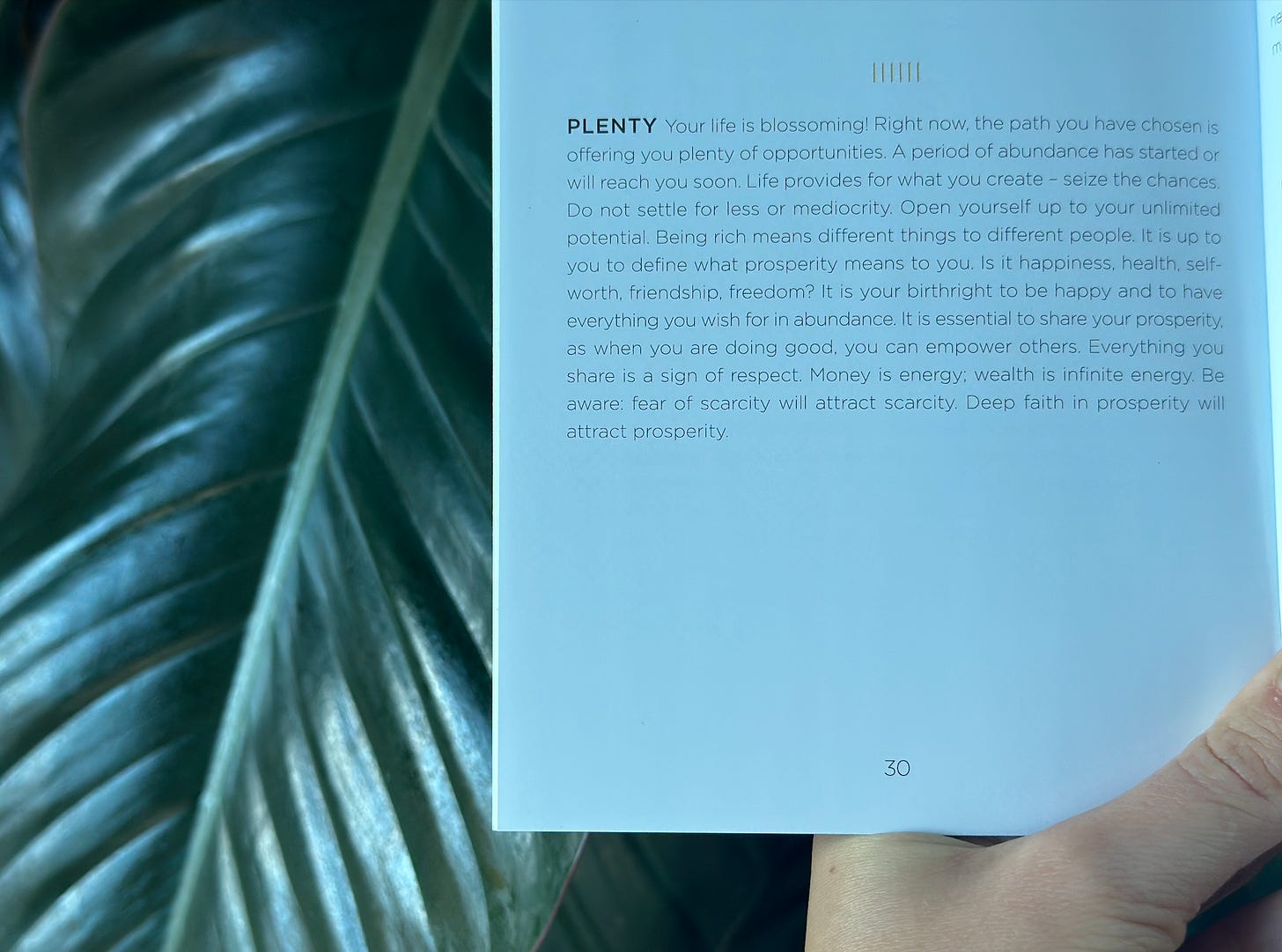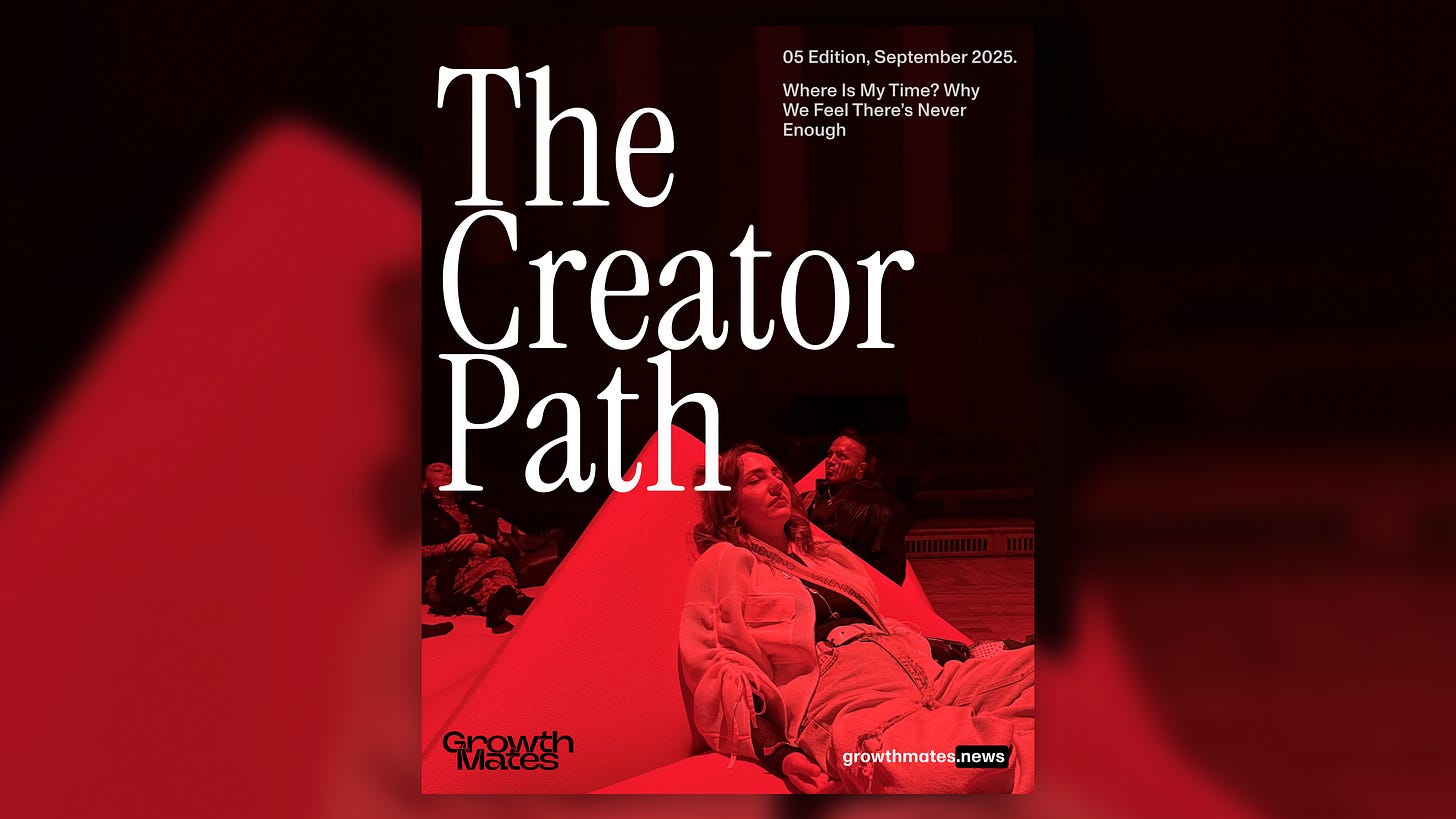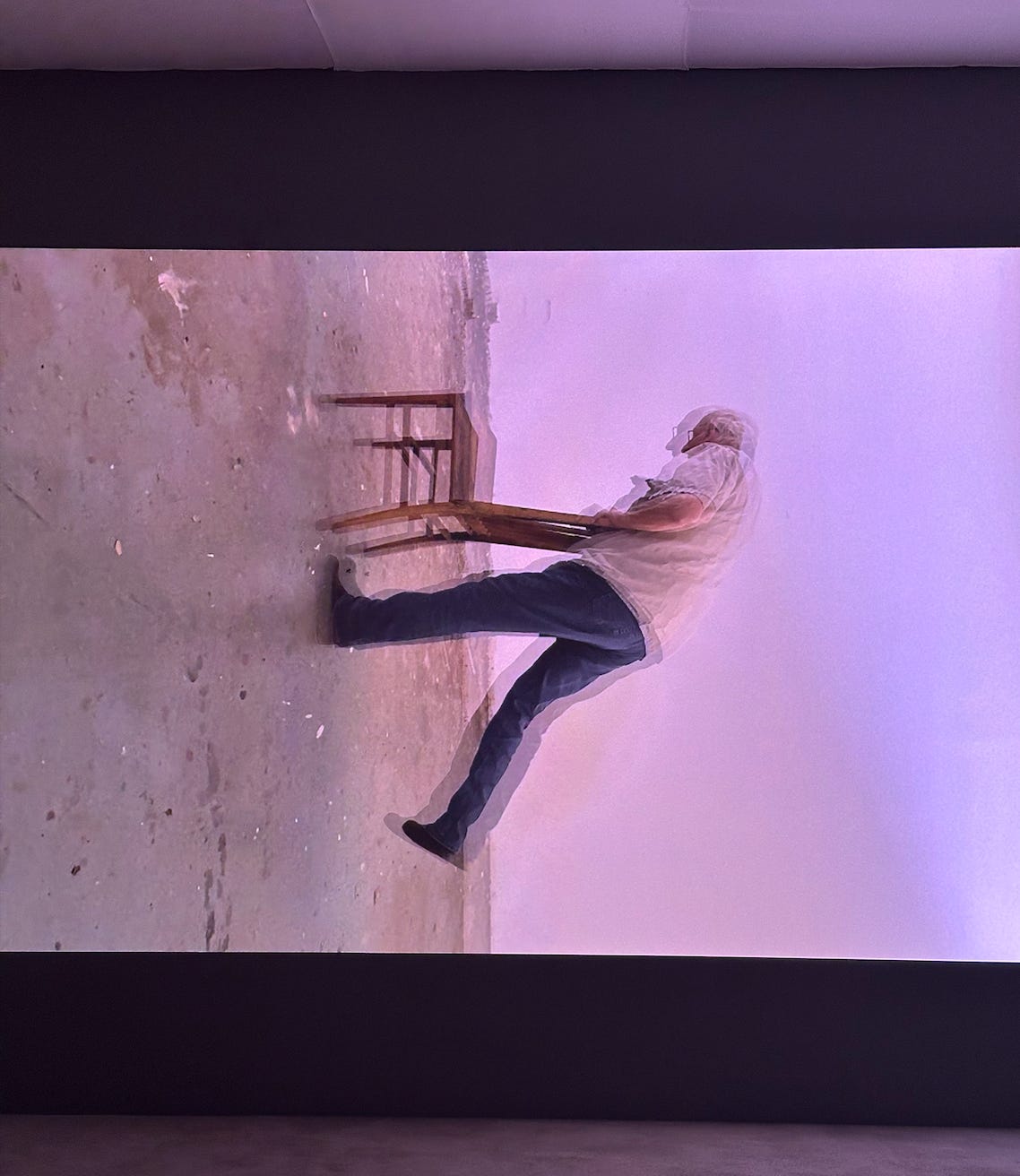⏳ Where Is My Time?! Why We Feel There’s Never Enough
New edition of "The Creator Path": rethinking our relationship with time.
Hello everyone 👋 I’m Kate Syuma, and welcome to Growthmates.news — the newsletter where we explore growth stories to inspire your professional and personal growth. Join the community of 7,000+ Product, Design, and Growth people from companies like Amplitude, Intercom, Miro, Atlassian, Grammarly, Framer, and more.
I suddenly realised that my default state is “constant rush”.
How many times have you said someone this week, “I’m too busy” or “I have no time”? I caught myself saying these replics too often, but is it true or just an illusion?
We often find ourselves caught in the trap of being too busy, but in reality, each one of us has a unique perception of time. Recently, I noticed that solopreneurship has started shifting my attitude to owning my time, and how it has changed my entire life.
In today’s issue of the monthly rubric “The Creator Path 💫”, I invite you to take a few minutes of your time and reflect on your relationships with time. My intention is to help you view this from a different perspective, share some useful insights I've recently uncovered, and unlock more time for meaningful and creative work.
This is not a “productivity hack” post — I’m not an expert in that field, and have no plans of becoming one. I’m just a human who has reached the extremes of time scarcity, felt its damaging effects on my daily well-being, and I want to create a new attitude toward it.
Before we dive in… Meet Growthmates Partners 🚀
I curate the Growthmates Bundle to share not just ideas — but the tools I trust and use in my own work. Each one is a handpicked #1 tool for a key product area, and I’m proud to have them supporting this newsletter 🖤
Best way to support Growthmates? Explore these fantastic tools below 👇
Framer — the fastest way to design and publish stunning websites (Growthmates.club is built on it).
Mobbin — the largest UX & UI reference library for deep product inspiration.
Beacon AI — the smartest AI agent for product and design teams to identify and fix UX issues that block activation, retention, and conversion.
Now, let’s dive into today’s story 👇
“Busy” is a decision.
The other day, I was reading my favorite table book, “In the Company of Women” (which also inspired a season with women on Growthmates Podcast 💜), and one quote caught my attention:
“Busy is a decision. You don’t find the time to make things, you MAKE the time to do things.”
Debbie Millman (Writer, Radio host) from “In the company of women”.
It hit me: every time I say “I’m too busy,” it’s a decision rather than an actual state. Trust me, I said it too many times, and after that, it became a constant norm for me.
If I’m writing a post, I feel rushed and don't have enough time. Or replying to emails back-to-back. Or running to my yoga class, trying to be on time for a 60-minute ashtanga practice. Do you remember that brilliant performance? “If you are rushing to get to yoga class, you are doing it wrong.” Namaste to this 🙏

In contrast, when I feel like I have plenty of time, I accomplish more tasks. It doesn’t count in the checkboxes crossed during a day, but in longer-term results achieved. Creative things don’t just appear in 30 minutes between back-to-back meetings — they require space to get born.
When I started my course on User-Centric Product Growth, I created a three-month thinking space to nurture this idea. When I thought of Growthmates Playbook, it took me 2 months of considering, choosing between ideas, and collecting the right content for it. When I was shifting my entire career 2 years ago, it took me 3 months to decide I needed to quit Miro and start my own thing.
Significant changes require space and time — the constant “busy” trap will not leave any room for new things to emerge.
Feeling busy or slowing down — both are decisions we’re making ourselves.
How I “bought back“ my time.
I was listening to “The Art of Accomplishment” podcast — “Why You Never Have Enough Time”. I love this show and highly recommend it to anyone who’s on a path of self-discovery.
The fun fact — I made time to listen to this, while I made time to go to a farm on Friday afternoon to pick some apples. 🍏 That was a great decision to make, as everything I’m writing about today was created in my mind that day, when I was riding a bicycle on maybe the last sunny day in Amsterdam this year.
One of the themes they were discussing was that in an employee state, we don’t track the time. I remember when I became a manager (Head of Growth Design at Miro) and had a team of 10+ people, I didn’t feel that I owned my time anymore. I had up to 7 hours of meetings every day, some of which were 15-minute quick chats, and in total, I could interact with over 50 people a day. I also had a Wednesday “no meetings” day, but it didn’t matter anymore — I felt burned out, not being able to fully concentrate on creative work.
“People appear to need about one to three hours of social interaction per day (roughly 7–21 hours a week) to maintain psychological well-being. Too little increases loneliness, while too much can lead to stress and diminishing returns.”
— Social Connection Guidelines, 2023 Source
When I started my own projects, I realized I needed more time for them to blossom. My evenings or weekends didn’t feel enough anymore. I made a very expensive decision — buying back my own time.
I hear a lot about this concept from people who are nearing retirement. I made that decision when I was 27. I wanted to buy my time back to use it now, not to delay till the late 40s or 50s.
That was a mental shift, and for the first year, I was still trapped in filling my time with tasks and meetings, becoming the strictest manager for myself.
But 2 years from that moment, I feel very different. I have plenty of space in my calendar — to be very honest with you, I have a maximum of 2 hours of meetings/day, and absolutely no work-related meetings on Wednesday and Friday.

After buying back my time, I realised how precious it is. I want to spend it on quality time with myself, nature, family, creative work — not on constant meetings. This is why my ways of working at Growthmates take into account my time, which is quite expensive:
I’m charging more for 1:1 short-term intense work (like an Onboarding sprint) — charging more, as I’m dedicating my whole attention to that work.
I’m not taking more than 3 clients in parallel, and I work with each 1-2 hours per week. When people ask me, “Is it enough? ”, I share how much I can deliver in 60 minutes with all the knowledge I have collected over the last 8+ years.
I create space for a more affordable group format in my course, as I can teach 20+ people simultaneously, while doing my best and spreading a ton of energy in a room for each session.
But to have energy for this, I need free time in between. Sometimes, I have to say no to opportunities that can overstretch me (and possibly bring in more leads or clients), but I prefer to conserve energy on existing work.
AI seems to save time, but doesn’t give it back.
While I was listening to this podcast, another data point shocked me:
“In a survey of 2.5 million Americans conducted between 2008 and 2017, 80% said they felt they did not have time to do what they wanted or needed to do.”
— Scarcity makes people short-sighted? Evidence from time scarcity mindset studies (PMC, 2023) Source
80 percent is a staggering number — and even though I’m not American, I often feel, and hear from others, just how real the problem of “time scarcity” is.
Some sources say that “the use of Artificial Intelligence (AI) is saving workers an average of one hour each day, allowing more time to be devoted to creative tasks”.
Living from a sense of “plenty”.
Instead of being trapped by the scarcity effect, we can live from a sense of plenty — there’s plenty of time, opportunities, people around us.
Sometimes I open a box of intention-setting cards — one of them called “Plenty” where it’s beautifully said:
The fear of scarcity will attract scarcity. Deep faith in prosperity will attract prosperity.
The Inner Compass Cards

With that in mind, I would like to invite you to acknowledge all that we already have, rather than chasing what we don’t have yet. I’m grateful to have this community of 7,000+ people who read this weekly newsletter — that means a lot to me 💜
Before you go...
Today’s post was a bit different from what I typically share here or do for a living — but all my work is connected to one mission: helping each other grow and inspire you to create meaningful things.
Beyond this newsletter, here are a few ways I can be helpful :)
User-centric Growth Course (Next cohort is already filling up for January ❄️)
I created a bit more space for myself to make this cohort even better — I’m enhancing the course with new materials, diving deeper into AI ✕ Behavioral Psychology to help you grow products in the AI era while staying user-centric.
👉 Join with 100$ off → (promo “growthmates” for dear readers)Onboarding & Activation Design Sprint 🏃♀️ (Opening slots for Q1 2026 🚀)
This is the most hands-on format, where I work with your team for 2 weeks to fix onboarding and improve the first user experience — often leading to a 2x uplift in activation.
👉 Check how it works →Brand Partnerships 📩
Let’s tell your product story to a trusted audience of 25,000+ product, design, and growth leaders — and co-create meaningful content that inspires the wider product and design community.
👉 Book intro call to discuss partnership →
This is all for today, dear readers. If you found this helpful, please share your reaction and leave some comments 💜 It would give huge support for me to continue creating this!
If you find this newsletter valuable, share it with a friend, and consider subscribing if you haven’t already. There are some discounts available, and maybe you can expense this :)
Connect with me on LinkedIn and learn more about my work on Growthmates.club.
With best regards,
Kate Syuma







What a waste of time this chatgpt written article was.
When copy pasting from chatgpt at least try to remove the utms from the links its shares to you
https://www.socialconnectionguidelines.org/en/evidence-briefs/how-much-social-time-do-we-need?utm_source=chatgpt.com